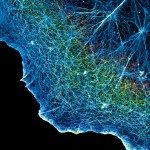Link to Pubmed [PMID] – 36840746
Link to DOI – 10.1093/nar/gkad034
Nucleic Acids Res 2023 Apr; 51(6): 2614-2632
Genome-wide chromosome conformation capture (Hi-C) has revealed the organization of chromatin into topologically associating domains (TADs) and loops, which are thought to help regulate genome functions. TADs and loops are understood as the result of DNA extrusion mediated by the cohesin complex. However, despite recent efforts, direct visualization and quantification of this process in single cells remains an open challenge. Here, we use polymer simulations and dedicated analysis methods to explore if, and under which conditions, DNA loop extrusion can be detected and quantitatively characterized by imaging pairs of fluorescently labeled loci located near loop or TAD anchors in fixed or living cells. We find that under realistic conditions, extrusion can be detected and the frequency of loop formation can be quantified from fixed cell images alone, while the lifetime of loops and the speed of extrusion can be estimated from dynamic live-cell data. Our delineation of appropriate imaging conditions and the proposed analytical methods lay the groundwork for a systematic quantitative characterization of loop extrusion in fixed or living cells.



